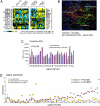Residual breast cancers after conventional therapy display mesenchymal as well as tumor-initiating features
- PMID: 19666588
- PMCID: PMC2720409
- DOI: 10.1073/pnas.0905718106
Residual breast cancers after conventional therapy display mesenchymal as well as tumor-initiating features
Abstract
Some breast cancers have been shown to contain a small fraction of cells characterized by CD44(+)/CD24(-/low) cell-surface antigen profile that have high tumor-initiating potential. In addition, breast cancer cells propagated in vitro as mammospheres (MSs) have also been shown to be enriched for cells capable of self-renewal. In this study, we have defined a gene expression signature common to both CD44(+)/CD24(-/low) and MS-forming cells. To examine its clinical significance, we determined whether tumor cells surviving after conventional treatments were enriched for cells bearing this CD44(+)/CD24(-/low)-MS signature. The CD44(+)/CD24(-/low)-MS signature was found mainly in human breast tumors of the recently identified "claudin-low" molecular subtype, which is characterized by expression of many epithelial-mesenchymal-transition (EMT)-associated genes. Both CD44(+)/CD24(-/low)-MS and claudin-low signatures were more pronounced in tumor tissue remaining after either endocrine therapy (letrozole) or chemotherapy (docetaxel), consistent with the selective survival of tumor-initiating cells posttreatment. We confirmed an increased expression of mesenchymal markers, including vimentin (VIM) in cytokeratin-positive epithelial cells metalloproteinase 2 (MMP2), in two separate sets of postletrozole vs. pretreatment specimens. Taken together, these data provide supporting evidence that the residual breast tumor cell populations surviving after conventional treatment may be enriched for subpopulations of cells with both tumor-initiating and mesenchymal features. Targeting proteins involved in EMT may provide a therapeutic strategy for eliminating surviving cells to prevent recurrence and improve long-term survival in breast cancer patients.
Conflict of interest statement
The authors declare no conflict of interest.
Figures




Comment in
-
The changing faces of cancer cells.Nat Rev Mol Cell Biol. 2010 Jul;11(7):466. doi: 10.1038/nrm2923. Epub 2010 Jun 16. Nat Rev Mol Cell Biol. 2010. PMID: 20551963 No abstract available.
References
-
- Dick JE. Stem cell concepts renew cancer research. Blood. 2008;112:4793–4807. - PubMed
-
- Li X, et al. Intrinsic resistance of tumorigenic breast cancer cells to chemotherapy. J Natl Cancer Inst. 2008;100:672–679. - PubMed
-
- Perou CM, et al. Molecular portraits of human breast tumours. Nature. 2000;406:747–752. - PubMed
Publication types
MeSH terms
Substances
Grants and funding
LinkOut - more resources
Full Text Sources
Other Literature Sources
Medical
Molecular Biology Databases
Miscellaneous

